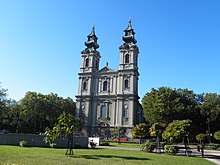The Catholic Church in Serbia (Serbian: Католичка црква у Србији, Katolička crkva u Srbiji) is part of the worldwide Catholic Church in Serbia, under the spiritual leadership of the pope in Rome. There are 356,957 Catholics in Serbia according to the 2011 census, which is roughly 5% of the population.[1] Estimates in 2020 suggested that the figure had risen to 5.5-6%.[2][3]
Catholic Church in Serbia | |
|---|---|
| Serbian: Католичка црква у Србији/Katolička crkva u Srbiji | |
| Type | National polity |
| Classification | Catholic |
| Orientation | Latin |
| Scripture | Bible |
| Theology | Catholic theology |
| Polity | Episcopal |
| Governance | International Bishops' Conference of Saints Cyril and Methodius |
| Pope | Francis |
| Region | Serbia |
| Language | Serbian, Latin |
| Members | 419,377 (2022) |
Catholics are mostly concentrated in several municipalities in northern Vojvodina, and are mostly members of ethnic minorities, such as Hungarians and Croats.


History
editThe first official Concordat between the former Kingdom of Serbia and the Holy See was concluded on 24 June 1914. Through the Second Article of Concordat, it was decided that the regular Archdiocese of Belgrade should be created.[4] Because of the outbreak of the First World War, those provisions could not be implemented, and only after the war were new arrangements made.
In 1918, Serbia became part of the newly formed Kingdom of Yugoslavia. By 1924, the Archdiocese of Belgrade was officially created and the first Archbishop appointed. Negotiations on a new Concordat between the Kingdom and the Holy See were led by the Yugoslav Minister of Justice Ljudevit Auer and Cardinal Eugenio Pacelli (who later become Pope Pius XII). The Concordat was signed in 1935, but was never officially ratified because of a political crisis in Yugoslavia (1936-1937).
Hierarchy
editThe Latin rite hierarchy consist of a metropolitan Roman Catholic Archdiocese of Belgrade and its suffragans, the diocese of Zrenjanin and the diocese of Subotica, and the diocese of Srijem (suffragan to Croatian archdiocese Đakovo-Osijek). The diocese of Prizren-Pristina (immediately subject to the Holy See) covers the area of Kosovo. The Greek Catholic Eparchy of Ruski Krstur serves the faithful of Byzantine rite.
Statistics
edit| 1921 census[5] | 1991 census | 2002 census | 2011 census | 2022 Catholic Church diocese statistics | ||||||
|---|---|---|---|---|---|---|---|---|---|---|
| Number | % | Number | % | Number | % | Number | % | Number | % | |
| Catholics | 751,429 | 17.16 | 496,226 | 6.4 | 410,976 | 5.48 | 356,957 | 4.97 | 419,377 | 6.30 |
| Total population | 4,378,595 | 100 | 7,759,571 | 100 | 7,498,001 | 100 | 7,186,862 | 100 | 6,647,003 | 100 |
Bishops' Conference of St. Cyril and Methodius
editThe International Bishops' Conference of Saints Cyril and Methodius is the International Catholic Episcopal Conference that includes Serbia, Kosovo, Montenegro and Macedonia. Permanent members are the Catholic bishops and archbishops from the four countries. Two bishops are authorized (Apostolic Exarchate) for jurisdictional districts of the Byzantine rite. As of 2012, the Chairman of the Conference is the Archbishop of Bar Zef Gashi. The conference is a member of the Council of European Bishops' Conferences.
Catholic organisations
editCaritas Serbia is a Catholic social welfare and humanitarian relief organisation operating all over the country.
See also
editReferences
edit- ^ See: Demographics of Serbia
- ^ Catholics and Culture website, retrieved 2023-08-08
- ^ The ARDA website, retrieved 2023-08-28
- ^ Concordat between the Holy See and the Realm of Serbia in 1914
- ^ Svetlana Radovanović (1995). Demographic Growth and Ethnodemographic Changes in the Republic of Serbia. Belgrade: Faculty of Geography.
{{cite book}}:|work=ignored (help)
Further reading
edit- Andrić, Stanko (2016). "Saint John Capistran and Despot George Branković: An Impossible Compromise". Byzantinoslavica. 74 (1–2): 202–227.